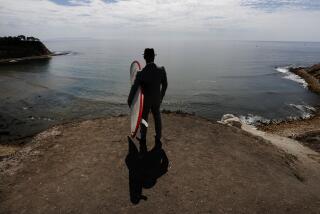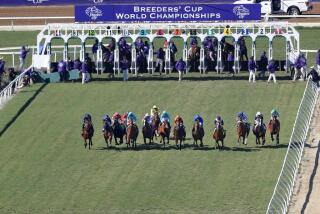U.S. to Put Cup on Line Against New Zealanders
- Share via
SAN DIEGO — The San Diego Yacht Club and Sail America Foundation, left with little legal latitude, said Wednesday that they will put the America’s Cup on the line against New Zealand’s Michael Fay next year but will pick their own time, place and boat.
They also said this was strictly between the United States and New Zealand.
“We intend to beat (Fay) on the water, sailing by the rules, then get on with an event in 1991 which we deem is the proper America’s Cup event,” Tom Ehman, executive vice president and chief operating officer of Sail America, said at a press conference at the yacht club.
The club and foundation announced last September that it intended to stage a defense off San Diego in 1991 in conventional 12-meter boats. Then last Wednesday, the New York Supreme Court upheld Fay’s challenge to compete for the Cup in 1988 in a boat with a 90-foot waterline.
Ehman portrayed that as an “interim America’s Cup Challenge” to be disposed of as “surgically clean(ly)” as possible.
Thus, the intent of the yacht club and Sail America is to abide by the terms of the century-old Deed of Gift that governs Cup competition, but to stack the ’88 competition as much in their favor as possible to assure a ’91 event. Fay based his radical challenge on those same terms, which others had ignored for 100 years.
“We say tit for tat in this country,” Ehman said.
A key factor will be to exclude all other challengers, a point certain to arouse protests from Australia’s Alan Bond and Britain’s Peter DeSavary, who have indicated they would also like to compete for the Cup in ’88 in the larger boats.
Ehman said, “San Diego will not consent to other challengers under the strict terms of this challenge. The answer is no--capital N-O, no.
“The 1991 event certainly will be open to all challengers from around the world. This next event will be conducted in strict accordance with the deed--a one-on-one match (between) the Mercury Bay Boating Club and the San Diego Yacht Club.”
Judge Carmen Beauchamp Ciparick has not yet signed and issued the specific order, a legal formality to follow her 19-page decision that ordered San Diego “to accept the challenge, forfeit the Cup or negotiate agreeable terms.”
The San Diego City Council voted unanimously Tuesday to appeal the decision and may be joined by New York Attorney General Robert Abrams, the yacht club and Sail America, although the latter two aren’t counting on winning an appeal.
Ehman said, “We don’t know what the situation is with respect to appeal until we see the court’s final order.”
Fred Frye, yacht club commodore, said, “We have no intention of forfeiting the Cup,” and negotiation seems out of the question in the currently bitter climate.
“Michael Fay was a clear victor,” Frye said. “The San Diego Yacht Club will defend this Cup wherever and whenever we are required.”
But where and when nobody was saying. All the defender is required to do is announce the site at least 90 days in advance. He doesn’t have to reveal his boat until the start of the first race--a practical impossibility, of course, considering the tuning and testing involved, but a point San Diego could press to the limit.
Ehman sent a three-page, single-spaced letter to Fay Wednesday “to confirm our plans for America’s Cup XXVII”--the first formal response Fay had received from his challenge since he handed it to Frye over lunch in San Diego last July 15.
Ehman listed the terms of the defense, which closely paraphrased the deed itself.
As he read it, he paused at one point and said, “Does all of this sound familiar?”
The letter closed: “Michael, we fear that the America’s Cup will suffer under this practice of literal compliance (with the deed).”
Fay said, “It’s ironic that they’re now using the deed to protect a position that will help them defend the Cup.”
He also disputed San Diego’s other major points:
--That the defender could sail a boat with a 115-foot waterline, “if of more than one mast,” according to the deed, or even a lightweight multihull.
--That the competition could be held anywhere in the world.
--And that San Diego can select the time, subject to the 90-day notice.
“The challenger has the inalienable right to choose the type of boat,” Fay said. “They can’t come out with a two-masted vessel.
“The venue is subject to ‘mutual consent (quoting the deed),’ and the venue is San Diego, unless the challenger agrees otherwise.”
Fay also said the defender must adhere to the rule requiring a defense 10 months after the first challenge.
“San Diego can’t take it upon themselves to impose conditions on the challenger,” Fay said. “San Diego can’t set down anything.”
The 10-month clock stopped for 2 1/2 months during the litigation and won’t restart until Ciparick issues her order. Fay now calculates that the first race would be “the third, fifth or seventh of September. The seventh of September sounds like a nice day.”
The deed calls for a best-of-three competition, with a day between each race, unless other plans are made by “mutual consent.”
Ehman conceded that the time-consuming dispute between the yacht club and Sail America over selection of a defense committee offered Fay his opening.
“I think that’s fair (to say but) had there not been an opportunist named Michael Fay . . . “ Ehman said.
Ehman disputed Fay’s contention--and Ciparick’s agreement--that Fay’s type of campaign would be less expensive than a longer, 12-meter program.
“The judge was really way off base there,” Ehman said. “It’s clearly a fallacy. Every 10 months, we’d have a tremendously expensive event.”
The situation will be discussed at a meeting of the International 12-Meter Assn. in New York next Wednesday. Fay plans to attend.
If the San Diegans wish to talk, he said, “We would be happy to meet with them on our way through the States.”
More to Read
Sign up for The Wild
We’ll help you find the best places to hike, bike and run, as well as the perfect silent spots for meditation and yoga.
You may occasionally receive promotional content from the Los Angeles Times.






